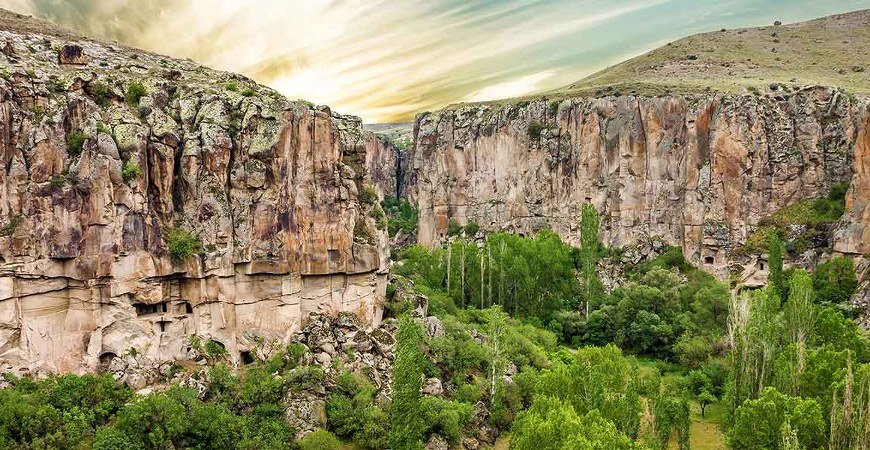
Ihlara Valley in Cappadocia Turkey
Ihlara Valley in Cappadocia Turkey,
Ihlara is reached by starting on the Nevehir-Ankara Road, then turning left at Km. 58 and driving for 40 km. It can also be reached from Derinkuyu by a much shorter road; it also lies on the Derinkuyu-Aksaray road (40 km). The 150 mt. deep Ihlara valley which is formed by erosion caused by the Melendiz River, is a place of great natural beauty containing hundreds of churches and it attracts thousands of admiring tourists every year. The mummy of a young girl found in 1960 in this valley is now in the museum at NiOde. The most beautiful churches along the stream of Ihlara, which extends as far as Belisirma, Yaprakhisar and Selimiye, are:
1) Yilanli Kilise (The Church with the snakes)
2) Agacgalti Kilisesi (The Church under the tree)
3) Sumbullu Kilise (The Church with the Hyacinthes)
4) Kirk Damalti Kilisesi (The Church under the Forty Roofs)
5) Bahattin Samanlig’i (Bahattin Barn)
Yilanli Church:
It is shaped like a long cross; in its western part, a grave has been excavated. On the wall in that part are pictures showing Michael judging people according to their sins and their good deeds. Immediately to the right is a picture showing sinners in the coils of snakes. The dome shows Christ and the angels: in the south-eastern part, we see Virgin Mary’s death. The church contains also pictures of the Last Supper, of Virgin Mary, of Saints and Angels.
Agacalti Church:
It is shaped like a cross and is older than the other churches but its frescoes have been relatively well-preserved. On the wall facing the door, we see Daniel between two lions and on the ceiling a dragon.
Sumbullu Church:
It is also shaped like a cross; its frescoes date from the XIV century.
Kirk Damalti Church:
Certain Biblical stories appear in its frescoes, among them the murder of Zacheriah.
Guzelyurt (Kalveri-Gelveri)
This town, situated in a valley in the Northern skirts of Hasan mountain at the southwestern part of Cappadocia, is 15 km away from Ihlara and 40 km. away from Derinkuyu. It appears from the ceramics found at the High Church and at the valley in the western part of the town, that the history of this town dates back to old times and that it was one of the most important market centers during 2500 B.C. The settling of the Prehistoric Age remains today without changes and people continue a life intermingled with past history. Some sources state that THEOLOGOS, who made the calendar which replaces the Persian calendar used in Anatolia before Christ, was born in Nazianzli (today called Nenezi) and that theologian Gregorios was born in Kalveri (today called Guzelyurt) and that
Kalveri became a religious centre after Gregorios was declared a Saint. Prehistoric settings before Christ, rock churches, and chapels, Rock Mosque, Great Church, High Church belonging to the period of after Christ is very interesting. Ceramic art in Guzelyurt was so developed that it still continues nowaday and the pots and other earthenware from Gelveri are very famous in the region of Cappadocia. The earthenware made here is different in form and structure from the ones made in Avanos, and are made from fire resistant soil. At the location of fox path and Pinarca two underground tunnels were found, but they are still blocked. Although village people say that one of the tunnels goes towards Ihlara stream and the other towards Hasan mountain, this remains uncertain.